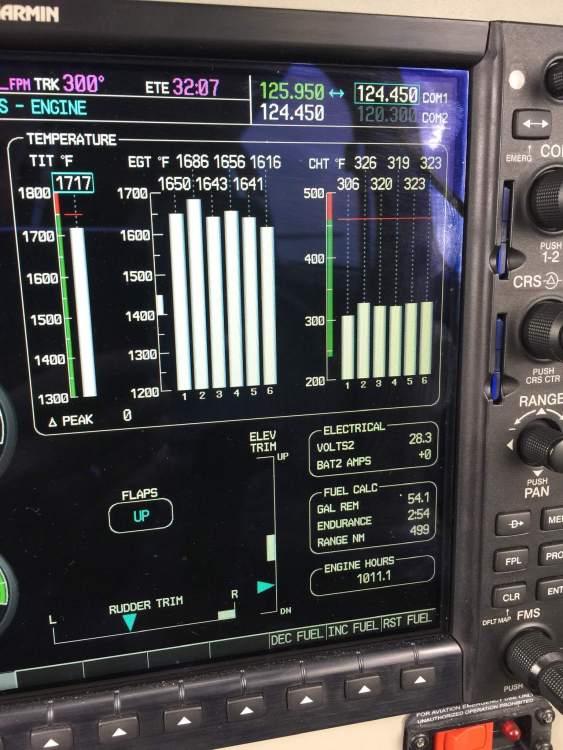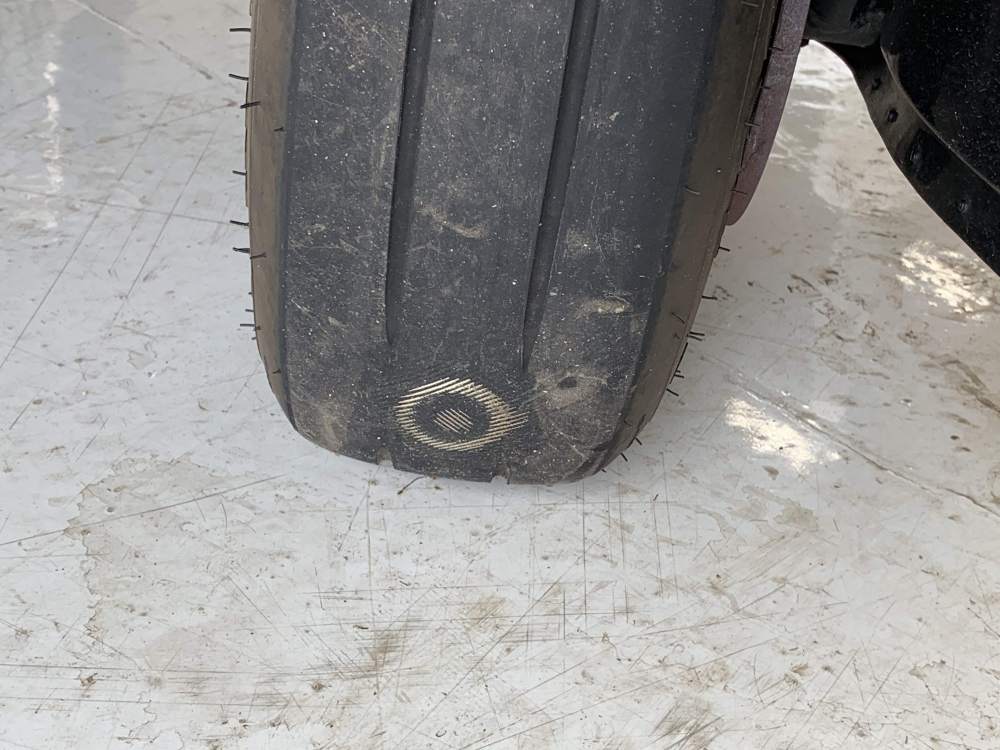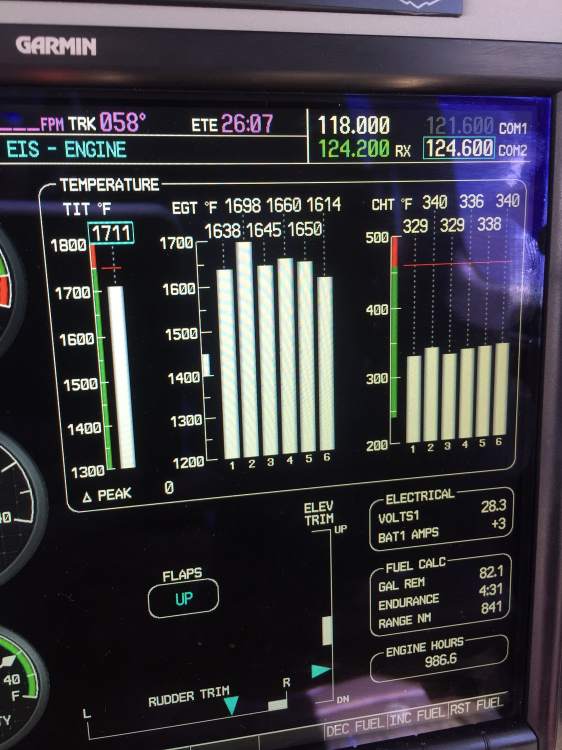-
Posts
1,595 -
Joined
-
Last visited
-
Days Won
2
Content Type
Profiles
Forums
Blogs
Gallery
Downloads
Media Demo
Events
Everything posted by exM20K
-

The Maxwell's home burned down yesterday.
exM20K replied to ragedracer1977's topic in Miscellaneous Aviation Talk
This Dan hasn't been all that helpful to you - except maybefor selling you a super clean Cherokee back in the 90's Don has been super helpful to me as well. -

The Maxwell's home burned down yesterday.
exM20K replied to ragedracer1977's topic in Miscellaneous Aviation Talk
It’s less about financial assistance and more about a gesture of caring and concern. No go fund me campaign is likely to even make the financial needle quiver with respect to insurance proceeds, but it must be gratifying to know your friends and customers care and are thinking of you. -dan -
I was told OH/Exch would be longer. Maybe that's what your A&P is trying. -dan
-
Turn around time from Garmin on my GTX33 to GTX33ES was under a week. Job was finished yesterday.
-
David, Speedbrakes will kill 20 KIAS in level flight at cruise, so it's hard to imagine you have an aerodynamic cause. Speedbrakes are big and situated for maximum damage to airspeed. Try a 3 way GPS test like this one and see where you are reference book best economy or best power. I'd look carefully at pitot static system. Good luck. -dan
-

Vortex generators on an Ovation?
exM20K replied to ilovecornfields's topic in Modern Mooney Discussion
so that's vs: 57 KIAS in an Acclaim S. 1.2*5 KIAS is 6 knot reduction in 1.2Vso VREF. Is the float factor 100 or 200' per knot? -de -
Have you done a careful, slow GAMI lean test, noting the FF where rack cylinder peaks? If they are close, then I would suspect an ignition problem: mags or harness. Actual EGT number is not meaningful, and it is normal for the rear cylinders to be higher since they are exposed to the other two’s exhaust going by. This is what mine looks like at peak while leaning: Er standby. Tapatalk won’t let me upload a picture..., fixed it. I find that taking a picture of the display helps leaning to at least 50* LOP for each cylinder. Usually this requires 65* LOP TIT as #5 runs a little richer than the others -dan
-
Or maybe the downside of lots of short field landings... I swear: I never heard a skid. But the evidence is hard to refute:
-
-
What if things go bad? As a seller, I’d want a signed purchase agreement and substantial deposit in hand, not with an escrow agent. The purchase agreement should state that buyer and seller will agree on how to remedy any airworthiness items. If they can’t, seller returns deposit. But what if buyer complains about rusty screws and a stain on the seatbelt and demands seller make these repairs? All while the plane is somewhere else? Seller is in a bad position. suppose buyer flakes out, goes dark, and doesn’t pay the shop that did the prebuy? Now your airplane is somewhere else, with a mechanic’s lein on it. Ugh. Escrow agents will, in my experience, almost always return a deposit if a deal breaks. Id suggest finding a local Mooney owner and ask him or her who wrenches on their plane. -de
-
I think you're right.
-
My recollection is that someone from the Mooney list was working with his widow some time ago to work on publishing rights, but I guess that never happened. -dan
-
I’m kinda like you. Couple thousand hours in a 231, sold it in 2008, and bought the Acclaim in 2016. They fly differently. Get with @donkaye or another qualified instructor. Where are you located? I’d be happy to fly with you in Chicagoland. -dan
-
WAAS units, too.
-
I don't think people consider this enough. Yes, resale is helped with WAAS, but for a plane you're planning to keep for a long, long time, careful weighing of "nice" vs "need" to have is important.
-

Vortex generators on an Ovation?
exM20K replied to ilovecornfields's topic in Modern Mooney Discussion
The VG-induced speed reduction for a TKS plane will probably be different from a clean wing, so I totally agree with Mike that it's plane specific, before/after. I run my TKS plane at 65* LOP mostly, and the fuel flows are lower than the book values for 29x2500 - I find the power settings tables pretty much useless with their 0/5 GPH up or down for 10* colder/warmer than standard temp. 13.5 x peak or modestly LOP fuel flow in GPH is what I recall the horsepower conversion factor to be from the APS people FF x conversion factor = HP; number for low-compression TSIO 550.) 75% of 310HP /13.5 = 17.2 GPH. That is what I'd target if I wanted to be super precise about it. For flight planning purposes, I use the slider in Foreflight to retard the 29x2500 Best Economy cruise speed and fuel flow by 8% and 4% respectively, and that is usually right on. Standard day @ 16,000, 29x2500 = 17.4 and 214 KTAS in the book best power chart, So I'll call that "close enough" to 75%. Anyway.... I, too, am really interested in a before / after or % less than book speed at a known power setting or fuel flow LOP. On a TKS plane. I'm on the cusp of getting VG's, but the potential for speed loss keeps me from pulling the trigger. As with so much in aviation, the loss may be a good trade for the performance benefits - especially for someone like me who bases an Acclaim at a <2600' strip. Is a further 4% speed reduction acceptable? 10%? 2%? Dunno. I'd plug those into Foreflight and see if I really care for my typical trips. But doing so would require me to make a decision rather than dwell on it more :-) PS: Kevin Kammer told me at DMAX last year he does the stall speed tests in new production planes and for certification at 3100# and 45". I suspect the CG may influence Vso as well as cruise speed. I've recorded these for my plane and will report back if I do get VG's. -dan -

Help needed on lean assist function G1000
exM20K replied to Knuckledragger00's topic in Mooney Bravo Owners
Not sure about auto-lean. The most recent software does show degrees from peak TIT, but it doesn’t leave a mark at peak ETG for each cylinder. Since I care most that the richest cylinder is at least 50’ LOP, and since they all do peak at about the same fuel flow, I just take a picture of the display at peak TIT to be sure. -

Help needed on lean assist function G1000
exM20K replied to Knuckledragger00's topic in Mooney Bravo Owners
My procedure for 29x2500 Lean O'Peak: Big Mixture Pull back to about 16 GPH or whatever it takes to get a noticeable reduction in power. Hit lean button on engine page. Add fuel slowly until peak (usually 1705-1715). Re-lean to 50-65 LOP The Big Mixture Pull gets you through the detonation danger zone (Red Box, for those who have taken the APS Red Pill) quickly. Brief time spent above 1700 while establishing peak shouldn't hurt anything. If you were getting peak at 1650' on a TSIO550 running 2500 rpm and 28-29", something was not right. One other things to check: is your fuel flow accurate? Mine had a dirty connector and was reading low. And TIT probes will read low when they are failing. -dan -
Understatement of the year. I've exported three aircraft to China, and they simply were not set up to receive piston GA aircraft. The Acceptance Checklist CAAC sent me (when they resent it in english, the second time) was obviously oriented towards transport category planes. For example: check box for "#3 engine: no hydraulic leaks" Pretty sure I can check that one on a DA20. No doubt they will get there, but my experience is that there is a culture of risk-aversion and no appetite for taking ownership of/solving bureaucratic jams. this was a couple years ago - maybe better now. -dan
-
and a lot of the damage is from FD cutting away the roof to extract the people.
-
This is what I meant by moral hazard. Bad attitudes and bad decision-making are trained out. Pulling the BRS is easy. Not getting into a situation requiring a BRS pull is about training. -dan
-
The Cirrus accident rate has gone from atrocious to better than average in recent years. Why? Commitment to a training and safety culture by the owners' group. That is not just encouraging people to pull the chute early and often - it also deals with LOC issues especially around the runway. But the causal factor in the improvement in Cirrus safety has been training. Consider the latest Nall report. As per usual, major cause of both fatal and non fatal mishaps is "PIlot-related." That means lots of stuff, from preflight, to losing control on the takeoff, to running a tank dry, to flying into cumulo-granite, and many more. The proportion is around 75% for both fatal and non-fatal incidents. Clearly, if three quarters of incidents result from something a pilot did, then a focus on and commitment to training will yield profound, life-saving results. The time series of Cirrus mishaps proves this. I do not believe the statistics show Cirrus to be safer than Mooney because of the BRS. It helps in some circumstances but not in all, and it is reasonable to believe that, just as multi-engine pilots typically accept more risk than single-engine pilots, the presence of a BRS may carry with it a moral hazard that worsens outcomes. Again: I'm glad the Cirrus accident rate has come down significantly, and I believe that an objective observer would attribute that to a culture of safety, not a magic handle. ps: speaking of training....anyone else here going to the MAPASF PPP in ACY? -dan
-
True. And the business use case has changed dramatically - SETP's have obsoleted cabin class piston twins for business use, and many industries have consolidated: time was that a manufacturers' rep would be out calling on customers oh behalf of a number of different manufacturers. This was a perfect use case for GA. What with the customers and vendors consolidating into fewer and larger entities, internet catalogs and ordering, and sales automation, this role is significantly diminished.
-
I agree. The SR2x Cirrus is just a plane; the VK30 was innovative and sucked. The company is a marketing and selling machine. They are energetic and everywhere, and the results speak for themselves. I don't like the way they fly, and I believe that back-to-back flights would yield that same conclusion for most pilots....especially w/o the autopilot. There is a thread almost identical to this one going over at Beechtalk: "Our manufacturer puts no effort into marketing an obsolete product, and we're doomed." Some things to consider in this discussion here (channeling @carusoam): The dense and qualified lead pool for a new Mooney is not on this forum in the form of existing owners. I have sold dozens upon dozens of new Diamond aircraft over the last 12 years, and I don't recall ever selling a new DA40 to a legacy aircraft owner. Why? Because the price delta is way out of line with the performance delta. An $80,000 archer is not only one fifth the performance and capability of a new Diamond. The buyer wants new: new panel, new airframe, new warranty, etc. I'm that way with motorhomes - I know they depreciate like a falling rock, but I want mine new. This forum could definitely support a study of the viability of a factory refurb program as @mike_elliott suggests. That would be a smart move on the part of Mooney International, if they want to be in the worker market rather than the fabrication business. Yes, there is some fabrication of interiors and maybe cowlings, but the heavy lifting is in the existing airframe. Can they build in enough margin to make this work? It's worth study, especially considering my point above: they can sell to a cohort of owners who will not be likely new aircraft buyers. Were Mooney to hire a team of smart social media gir er, people, invest in demo tours, reach out to qualified prospects aggressively and on and on... are they presently equipped to make one plane a week? Do they have the ability to ramp up to 2x or 3x that? If not, then the sales & marketing spend is a waste of resources. M10: It is good they killed it. That plane did little that the well-established DA20/DA40/SR20/C172 doesn't do better. Training market is driven by fleet purchases now, and margins on those suck, so you're competing for what? Yes: everyone at OSH is blown away by their booth presence and energy level. They are everywhere IRL and on social media. ICON has a really boss booth at OSH and a pretty high-profile media position (positive, until recently). How's that going? Does Cirrus get a positive ROI on all the marketing spend? Only they know. Are they profitable? Only they know. Things Mooney can do: Investigate the economics of a refurb and/or CPO program Get the gross weight up without blowing out the runway numbers. Re-worked landing gear and VG's? Find or train CFI's in the type, and promulgate that information to the world. eg: here's a map of all the factory-approved Mooney instructors. Ditto service centers - there aren't enough. The new plane buyer doesn't want to dig deep to find out where he can get trained or get his new plane (under warranty) wrenched on. Create a community - proud owners on this forum, for example, who will evangelize. Make sure the existing owners feel supported. Contribute meaningfully to or acquire MAPA and/or homecoming. That doesn't cost a lot. Craft a marketing message to de-value the BRS. I don't know what that message is. The 'chute is very appealing to the non-flying spouse who tolerates the other's dangerous hobby. I always liked the "Time to lose your training wheels" campaign. It struck a great, cheek tone poking fun at a competitor and its dorky product w/o seeming mean or petty. But that campaign was only in aviation magazines. I think it's a winning message to broadcast widely. Cirrus does have a huge and enthusiastic group of owners, but that makes them not only the incumbent, but also a ripe target for a nimble, guerrilla marketing campaign for a better-performing, cooler product. All the other stuff - ramping up production, hiring a professional marketing firm, aggressively reaching out to qualified buyers, supporting demo tours, etc, is a chicken&egg thing that Mooney must figure out: invest in marketing to build a pipeline, or if selling everything they can make now, invest in productive capacity first? Or continue along as a hobby new-plane business with a viable parts/support core? -dan
-
Would a bank lend on that number? Don't know, but they do get a little hesitant on >30 or 40 years of airframe age. Lending officers rely on bluebook values to retain their employment when a loan goes bad. Would bluebook/Vref put that high a value on it? I really don't know. Other conversions/refurbs have price history (Jetprop, for example). A good test case would be how much would a bank lend on one of Mike Jones "Lock & key" Navajo's. -dan





